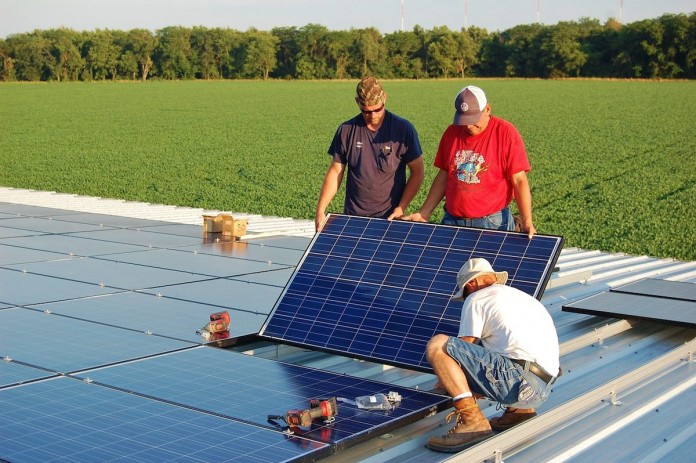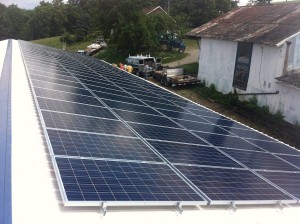NORWALK, Ohio — One of the most noticeable things about the large solar panels on Kurt Heyman’s family farm is, you don’t notice them.
The Huron County farmer had the panels installed on a machinery shed in July by a company from Michigan called Ecojiva.
The name stands for “living in harmony with our surrounding environment.”
Despite being 4,000 square feet, the panels are mostly unnoticeable, making them about as “harmonious” of a source of alternative energy as one can get.
What Heyman, 58, does notice is that his first few electric bills have turned into an electric credit — meaning he’s producing more than he uses. His system is designed to produce 50 kilowatts. On an annual basis, the unit will produce about two-thirds of his electric needs. He can add more panels later if he chooses.
Of course, those credits will balance out a bit during the winter, when the days are shortest. Then, as the days start getting longer, Heyman expects production will increase.
“The jury is still out, but we think it is going to be all right,” he said.
Large farm
Heyman is one of a dozen full-time employees on the family operation, which dates back to 1903 and is known as Enterprise Hill Farm.
Kurt farms alongside his dad, Chase Heyman, 86, and Kurt’s siblings and their children.

The Heymans farm 3,300 acres of conventional crops like corn and soybeans, and also raise popcorn andcabbages, and manage a custom hay-making business. Their popcorn is produced for ConAgra and is marketed as the popular Act II brand. The cabbages go to Fremont Co. and are used for sauerkraut.
Going solar wasn’t an easy decision, but the more Kurt and his family learned about it, the more they liked. Because the panels are located on the top of the roof, they’re never in the way. The inverter boxes, which convert the electric from DC to AC current, are located inside the shed, mounted neatly against a single wall.
“That was one of the things that looked good to us, is there’s nothing to go wrong with them,” Heyman said. “The biggest risk is a storm wrecking something, but the way they’ve got it fastened to the roof, it’s not going anywhere.”
The unit is guaranteed for 25 years and the return on investment is projected to be three to four years.Perfect place. Jess Ennis, the Hudson, Ohio, salesman who sold the Heymans their unit, said farms are often the perfect place for solar.
For an extensive listing of solar websites in Ohio and the nation, visit Solar Energy Industries Association
“First of all, a lot of them use a lot of electricity,” he said.
Whether it’s a grain or livestock operation, or even a produce farm — there are always motors to run, fans, shop equipment and lights.
The other factor is, most farms have space — usually atop large metal roofs.
“You might as well put it to use and make your own electricity,” Ennis said.
So far, nearly 100 farms and farm-based businesses have taken Ennis’ advice, and he has more projects in the works.
Word of mouth
The units are contagious. One farmer installs one, and others follow.
One of the Heymans’ neighbors, Marc Ruggles, installed a 15 kw unit this fall.“Heymans had it so we thought, well, we’ll try it,” said Ruggles.
He farms 1,200 acres with his wife, Betsy, and family.
The Ruggles’ unit is similar to the Heymans’ unit, just smaller. It’s mounted to a machinery shed roof and the inverter boxes are inside, against the wall.
On the day Farm and Dairy visited, Nov. 13, the unit had produced about 17 kilowatts by about 1 p.m. Like the Heymans’ unit, production will go up considerably during spring and summer.
The Ruggles started using their unit Oct. 20. They applied for a renewable energy grant through the USDA, and assuming they receive it, they expect a return on their investment in about three years.
Other projects
Solar is catching on in other parts of the state, as well, like central and southeastern Ohio, where Third Sun Solar of Athens has made some installations.“It’s a sound investment,” said Gerald Kelly, communications director for Third Sun.
As electric prices continue to fluctuate and rise, solar helps give farmers stability.
“Solar can give you a very stable energy cost over several decades,” he said. “They’re (farmers) sharp business people and they take a little different point of view in that (they plan) long-term.”
A solar installation often involves many parties, including the installer, the farm operator, a utilities company, and a financial lender.
Renewable standard
Installers say utility companies — especially the large, publicly traded companies — are usually cooperative with solar systems. Part of the reason is, companies must meet
Ohio’s renewable energy portfolio standard, which requires the state to derive 12.5 percent of its energy from renewable sources by 2025, with at least half of a percent from solar.
As the private sector increases its use of solar, this helps companies meet the state requirement.
“It’s in their (utility companies) best interest to have their customers put in solar because that helps them achieve their mandated level,” Ennis said.
Among electric cooperatives, which are not required to meet the state standard, the mood can vary. But installers say most cooperatives have supported the projects, as well.
Incentives
With all the grants and energy assistance programs, farmers can get up to 90 percent of the installation cost covered.
Those incentives include a 30 percent federal tax credit, depreciation incentives, a solar renewable energy credit, grants from the U.S. Department of Agriculture Rural Energy Assistance Program, and any pertinent rebates.
Like many farmers, Heyman is conservative about the payback period. But even if it takes eight to 10 years, which is more than double what is expected, he said he will still come out ahead.
He encourages other farmers who are interested in solar to talk to an installer and do their homework. Under the right conditions, it’s a good investment.
“I think it’s got its place,” he said.
Get in touch: For more info. about Ecojiva, contact Jess Ennis at 330-835-7704, or visit www.ecojiva.com. For more about Third Sun Solar, call 740-504-8206, or visit www.thirdsunsolar.com.
Solar spotlight:
• Solar power is a growing industry in Ohio. Currently, there are 181 solar companies in the state, according to the Solar Energy Industries Association. Sixty-one of those companies have manufacturing facilities, and 51 are considered contractors/installers.
• Ohio ranks 15th nationally for solar capacity installed. Ohio has enough solar installed to power 8,300 homes.
• Prices for solar are getting cheaper. The average installed residential and commercial photovoltaic system price has fallen by 17 percent in the last year. Nationally, prices have dropped 11 percent over the past year, and 34 percent since 2010.
• Legislation in Ohio known as the Renewable and Advanced Energy Portfolio Standard requires electric utilities companies to incorporate a minimum amount of solar power by 2025. The state standard requires that 12.5 percent of energy come from alternative sources, with at least half of a percent from solar. While this amount may seem small, it is driving demand for localized solar projects.













?…did I miss something here? what is the COST of these solar panels?
maybe my feeble and ancient eyes missed the “Price label.”
c’mon, folks–you know the drill: who, what, when, where and HOW MUCH?
That is a good question. The cost to install is one of the biggest factors, as you point out, but because these units were installed by private farms, they declined to have the amount printed. The other thing is, the cost varies tremendously depending on how much grant money is received, the size of the unit, etc.
The cost for a farm unit can range from tens of thousands, to a few hundred thousand. This can be financed, if necessary. While this may seem like a big expense upfront, the advantage of course is the expected payback, which in the case of the Heyman farm unit, is projected at under five years.
Chris,
I sure enjoyed your story on Solar Power for farms. You’re right, the cost will vary by the size of the system needed and the incentives that can be applied…also whether it’s roof- or ground-mounted. (Of the 100+ systems we’ve installed on farms and other ag businesses, about 60% have been on rooftops, 40% on the ground.)
Does a solar power installation make sense for a particular farm? First we ask: …Is the electricity consumption there significant (at least $200/month in electricity costs, on average)?…Is there space available on a rooftop or the ground?…Is there a need for tax relief? If the answers are YES, then there’s a good chance that solar will make sense.
I will be happy to talk to interested folks and provide them with a customized profile of solar, including a quote…there’s no charge or any obligation for that. If it doesn’t look like solar makes sense for someone, I’ll say so. Folks can call me at 330.835.7704 or email at jess.ennis@ecojiva.com
Solar power…the greatest thing for farms since photosynthesis!
Jess Ennis, Sales Director
Ecojiva Solar
The print version of this story had a great chart of web resources for researching incentives. Will you publish and post it online alongside this article?
Hello, here is the link to the Solar Energy Industries Association, which has a link to all of those websites at the bottom.
Ohio State Solar Policy Resources
University Clean Energy Alliance of Ohio – Learn about the advanced energy research, education and commercialization activities taking place at universities in Ohio
Ohio Energy Project – Read about this energy education resource for students, educators and business partners in Ohio
Public Utilities Commission – Learn about the governing body that regulates the electricity rates and services of Ohio public utilities
State Legislature – Track pending legislation affecting solar energy, locate and contact individual legislators, and stay up to date on current legislative issues in Ohio
State Energy Office – Find a wide variety of information on state government energy programs, research, policy, projects, energy-saving strategies and energy-related statistics
DSIRE incentives database – Ohio – Search a public clearinghouse for specific solar energy incentives in Ohio and across the United States
U.S. Energy Information Administration – Ohio State Profile – Explore official energy statistics, including data on electricity supply and demand, from the U.S. government
Thank you. I enjoyed the article and plan to crunch some numbers to see if solar is feasible for us.
Great Article! We recently did a solar installation for a home. It was the largest residential system in Ohio, 60 KW!
If people have quesitons about specific numbers and cases give me YellowLite a call!
216-404-2591